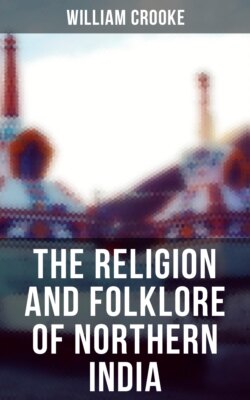Читать книгу The Religion and Folklore of Northern India - William Crooke - Страница 38
На сайте Литреса книга снята с продажи.
The Lake of the Fairy Gifts.
ОглавлениеTable of Contents
In the Chânda District of the Central Provinces is the lake of Taroba or Tadala, which is connected with an interesting series of folk-lore legends. A marriage procession was once passing the place, and, finding no water, a strange old man suggested that the bride and bridegroom should join in digging for a spring. They laughingly consented, and after removing a little earth a clear fountain gushed forth. As they were all drinking with delight the waters rose, and spreading over the land, overwhelmed the married pair. “But fairy hands soon constructed a temple in the depths, where the spirits of the drowned are supposed to dwell. Afterwards, on the lake side, a palm tree grew up, which appeared only during the day, sinking into the earth at twilight. One day a rash pilgrim seated himself on the tree and was borne into the skies, where the flames of the sun consumed him.” This part of the story reads like a genuine solar myth. “The palm tree then shrivelled away into dust, and in its place appeared an image of the spirit of the lake, which is worshipped under the name of Taroba, or ‘the palm-tree deity.’ Formerly, at the call of pilgrims, all necessary vessels rose from the lake, and after being washed were returned to the waters. But an evil-minded man at last took those he had received to his house, and from that day the mystic provision wholly ceased.”
This legend of the fairy gifts which are lost through the selfish greed of some mean-spirited man has been admirably illustrated by Mr. Hartland. It is also told of the Amner Lake in Elichpur, of the Karsota Lake in Mirzapur, and of many other places.124
Many of these lakes possess subaqueous palaces beneath their waters. At Cudden Point in Cornwall, the unhallowed revelry of a party of roisterers is heard from under the waves.125 In one of Somadeva’s stories the hero dives after a lady, and comes on a splendid temple of Siva; Sattvasila falls into the sea and finds a city with palaces of gold, supported on pillars of jewels; Yasahketu plunges into the sea and finds a city gleaming with palaces that had bright pillars of precious stone, walls flashing with gold, and latticed windows of pearl. So in the sixth fable of the second chapter of the Hitopadesa, the hero dives into the water and sees a princess seated on a couch in a palace of gold, waited on by youthful sylphs. The sage Mandakarni alarmed the gods by his austerities, and Indra sent five of his fairies to beguile him. They succeeded, and now dwell in a house beneath the waters of the lake called from them Panchapsaras. At the Lake of Taroba, the tale of which has been already told, on quiet nights the country people hear faint sounds of drum and trumpet passing round the lake, and old men say that in one dry year when the waters sank low, golden pinnacles of a fairy temple were seen glittering in the depths. This is exactly the legend of Lough Neagh, immortalized by Thomas Moore.
